 The sun glints off the enemy’s helmets as you squint across the field, gripping your spear and shield, knowing that soon they will be all that stands between you and death. A moment of calm, then the cry of battle as the enemy advances. Your archers release a counter-fire, sending a rain of arrows and taking down the front line of cavalry. Your unit receives the orders to advance and meet the enemy head-on. You march through the dust, and with a clash of metal and leather and the drumming of hooves, you go to meet your fate.
The sun glints off the enemy’s helmets as you squint across the field, gripping your spear and shield, knowing that soon they will be all that stands between you and death. A moment of calm, then the cry of battle as the enemy advances. Your archers release a counter-fire, sending a rain of arrows and taking down the front line of cavalry. Your unit receives the orders to advance and meet the enemy head-on. You march through the dust, and with a clash of metal and leather and the drumming of hooves, you go to meet your fate.
Battalion: War of the Ancients brings the great armies of old to your tabletop in a clash between two or four players, with a playtime of 20-45 minutes.
Gameplay Overview:
The standard setup for the game is designed for two players. First, choose whether you’ll use the setup for one of the set battles in the rulebook, or create your own armies with the ranks available in the game. A “rank” represents one group of soldiers of a specific discipline, such as Infantry, while a “unit” is made up of multiple rank tiles placed together on the battlefield and may consist of identical or different types of rank.
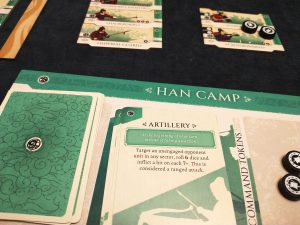
Each side chooses an army to command from Roman, Han, Greco-Bactrian, or Carthaginian. The battlefield is divided into three sectors. The assembled armies are placed into each player’s formation zone and space is left between the players’ assembled armies for the engagement zone. Players set their camp board behind their formation zone; this is where their battle deck and order tokens are stored. Each army’s deck is made up of a number of cards equal to the number of ranks (6-12) in that army, and they take the same number of order tokens, returning any extras to the box, then draw a hand of two cards.
On your turn, after a possible redeployment action, you can choose one of three options:
- Assault – Attack an enemy unit with which one or more of your units is already engaged.
- Charge – Move a unit from your formation zone to the engagement zone and engage the enemy. During a charge, your opponent may spend Order to react with a counter-fire or counter-charge.
- Barrage – Execute a ranged attack using one of your unengaged units and targeting an unengaged enemy unit.
In all cases, commanding a unit costs order tokens, which are placed on the unit at the start of the action. The cost is at least one order, but can be higher.
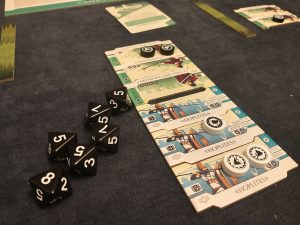
Alternatively, you may rally, skipping your turn to draw a card, recovering order, and removing disorder (essentially damage) from units.
For all attack actions, except barrage, if the targeted enemy unit is not disbanded (destroyed) from your initial attack, your opponent will make a counter-attack. Attacks are resolved using eight-sided dice, and a minimum of three will always be rolled, possibly more depending on keywords or if you discard. Any result of eight is a hit, as well as any number matching or equal to the hit value it’s assigned to on your unit. Command cards can also be played to affect the battle.
Damage is taken in two possible ways: by removing ranks from the unit or assigning disorder tokens (order tokens flipped to the opposite side). How much damage a unit can suffer depends on the “cohesion value” of the ranks that make it up. If a unit is destroyed, the player who lost the engagement is forced to draw a card.
A player loses if, at any point, they need to draw a card from their deck but cannot because it’s empty (cards are not reshuffled into the deck), or if there are no units left in their central sector.
The game can also be played in a team vs team mode with four players, and the battlefield divided into five sectors rather than three.
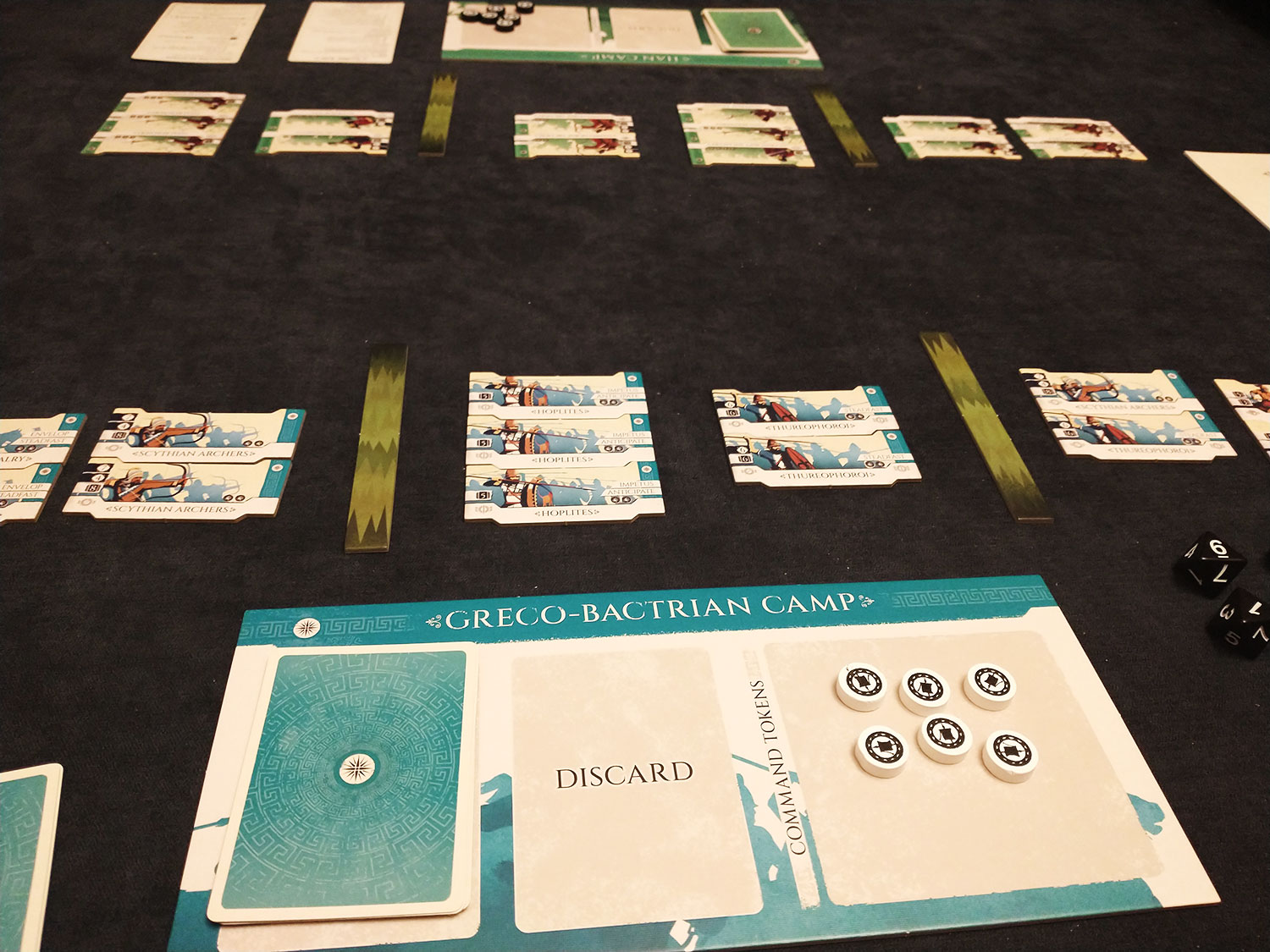
Game Experience:
Osprey is known for another line of medium-light war games that most have probably heard of: Undaunted. Naturally, going into this I wondered how the systems would compare. While I won’t spend this review lining those two up beside each other, I will mention that the two systems are completely different. Thematically it feels more like the company’s heavier Imperium line of games though, again, mechanically they are very different as they all have different designers.
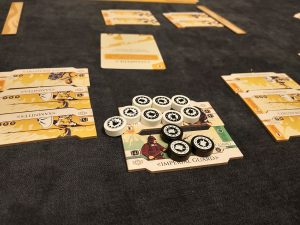
Battalion feels a little like a chit war game, except that instead of chits you have chunky tiles that are splayed on the table’s surface, rather than stacked, with information and names clearly visible. This makes it ideal for those wanting the war game-like experience without the intricacies and complexities of an actual war game. At the same time, it’s complex enough due to keywords and some nuances that I didn’t feel confident introducing it to my son who can play Memoir ‘44. This, I think, places it in a specific in-between zone and somewhat limits the game’s audience.
A hallmark of a good wargame, for me, is the thematic immersion, which is sometimes lost in more sterile and abstract strategy games with a pasted-on war theme. Battalion lands somewhere in the middle between the two. My mind plays a story throughout the battle, to a certain extent, and some exciting moments arise with the dice rolls, decisions, and card plays. So there is some of that immersion that I so love, but there’s also a good deal of abstraction. For one thing, you’re simply using the table as your playing surface, with a couple of strips of cardboard used to divide your armies into sectors. In a practical sense, I don’t lament the absence of a game board here, as it would probably be superfluous and might inhibit attempts to compose a grand battle with huge armies. At the same time, I feel it takes just a little from the immersion and theme of the game.
Part of my abstraction from what’s happening in the battles could be due to the fact that, while I like ancient history, I’m not particularly well acquainted with specific battles of old, upon which the set battles in this box, I presume, are loosely based. I say loosely because this is no ConSim, and that’s okay, it’s not claiming to be. But I do think those familiar with the era and these specific armies will get more from the game, thematically, than those with only a causal knowledge, like myself.
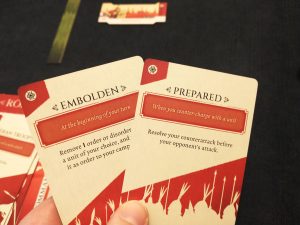
So what about the mechanisms? I think they work really well. The information on the tiles is clear and resolving attacks with dice is fun. While luck always factors into dice rolls, I didn’t find them to be especially punishing, since you know what your hit values are and can, at least some of the time, choose which unit to attack with and know your odds. There will certainly be desperate moments where the dice are against you, and you’ll somehow pull through, and there will be times when you chuck a handful of dice, but they all miss. That’s the nature of dice, and those of us who love them embrace that, as long as we have some measure of agency. And I do feel this game gives players enough agency to balance out the luck factor. It’s also pretty clear the game was designed for two, and the team play variant felt somewhat tacked on, but it’s nice to have that option there.
The game length is pretty reasonable, with small battles playable in a half hour, but bigger battles with more units taking an hour or so. The fact that players get a free counterattack helps the pacing of the game. Your deck also works as a timer since the game ends in defeat if you can’t draw a card when required to. If you have eight units, your deck consists of eight cards, two of which you draw at the start of the game. Any time you run out of command tokens and can’t take actions, or when you lose a unit, you have to draw a card.
This, again, keeps the game moving at a good clip. I applaud the designers for the choice to keep this game running smoothly with very little upkeep on a turn. It’s back and forth, back and forth, until somebody wins, with a bit of deliberating over major decisions here and there. The biggest hindrance to the game flow was having to check a lot of keywords, but thankfully players have reference cards for that. There were also some hitches that we got caught on from time to time, so we were often having to reference the rulebook. Also, some edge cases weren’t answered in the rules or the (rather spartan) FAQ document available from the publisher.
Final Thoughts:
I like this system. Rules hiccups aside, it’s clean and smooth, and the armies seem balanced with each having a bit of flavor to make it different from the others. The games don’t last overly long. Dice rolls feel exciting, and players still have a good amount of agency. Flipping order tokens to disorder for taking damage, and how disorder is recovered, works well. I did find Battalion: War of the Ancients to be somewhat abstract and wished for just a little more theme and immersion, even though it’s clear the designers did their research. The art is well done and thematic and the graphic design is clean. I think experienced war gamers would probably find the game lacking detail and depth, but for a strategy gamer looking for a war-themed game, this should be a good fit.
Final Score: 3.5 Stars – A little too abstract for my taste with some rulebook flaws, but still a lot of fun.
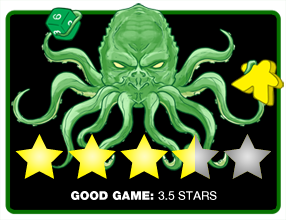 Hits:
Hits:
• Playtime and game-flow are spot on
• Good balance between luck and strategy
• Nice variety of ranks with unique strengths
Misses:
• Rulebook and FAQ could have been better
• Felt a little abstracted
• Somewhat limiting complexity level



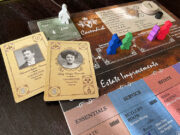

















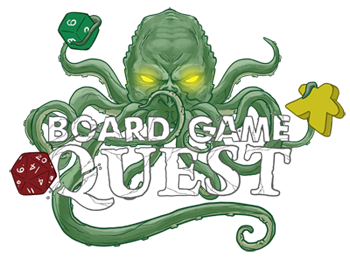
Great description. I’ve been playing the game for a couple of weeks. Conversely I found the game very reflective of ancient battles. I am a miniature wargamer and this game could easily replace the counters with models and still feel good. Each decision feels important and all the armies have specific strengths and weaknesses. Miniature wargamers will like this game…and it’s quick to play.